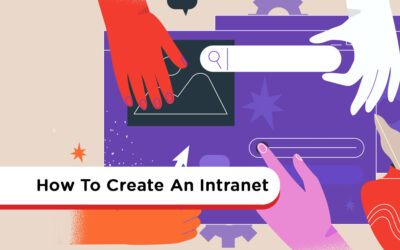Intranet Design Services
Choose from the self-build option with our support or work with one of our designers who will create a customized, fully-functioning intranet for your business, in 40 days or less, guaranteed!
The Challenge: Lack Of Time
You’ve defined your requirements and you know MyHub can deliver the outcomes you’re looking for. But do you lack the time and resources to customize your MyHub intranet site and get it launched on time?
The Solution: We Do It For You
By engaging with one of our designers, we’ll remove all of the complexity and risk by doing it all for you.
Planning For Success
Your MyHub intranet designer will lead the engagement process and ensure you’re updated on progress. The process is broken down into three key stages including:

Scope & Commercials
- Gathering requirements
- Defining launch objectives and timelines
- Developing a site plan including key pages, modules and content
- Agreeing the scope of works, pricing and terms.

Site Design
- Adding a company logo and changing site color options
- Designing and adding pages
- Adding content to pages including images, news articles, text, video and forms
- Adding folders and files to the Document Exchange
- Adding users to the site, Role Groups and Roles

Launch
- Handover and training
- Post-launch support
- Free site audit at any time
MyHub Designers, Delivering Great Outcomes
Intranet Design Articles
Cultural Audits: How To Assess Your Workplace Culture
Workplace culture plays a crucial role in shaping employee engagement, organizational behavior, and long-term business success. Yet many leaders struggle to define or evaluate their company’s culture in a structured way. This blog post introduces the concept of cultural audits—systematic evaluations that help identify whether a company’s culture aligns with its values and strategic goals.
The article breaks down the audit process into three stages: assessment, analysis, and recommendations. It outlines practical tools like focus groups, staff surveys, and document reviews, which help uncover both visible and hidden aspects of company culture. It also provides sample audit questions to guide internal reviews and elicit honest feedback from employees and stakeholders.
By conducting regular cultural audits, organizations gain actionable insights that can drive positive change. Whether performed internally or with the help of external consultants, cultural audits offer a clear roadmap to building a healthier, more inclusive, and performance-driven workplace. The post concludes with a call to action encouraging businesses to embrace cultural audits as part of their ongoing development strategy.
Onboarding LMS: Simplify Employee Onboarding with MyHub
Effective onboarding is a pivotal moment for new employees — shaping their experience, productivity and likelihood to stay. The blog argues that traditional onboarding methods (paper forms, disconnected tools, manual check-lists) often fail because they don’t align with how employees actually work. Embedding an onboarding Learning Management System (LMS) inside your intranet fixes this by placing training, resources and workflows where teams already spend time.
With an onboarding LMS built into your intranet, organizations can centralize learning content, automate key tasks (form completions, policy acknowledgements, role-based training), and track progress with real-time reporting. This ensures new hires can find what they need, complete required modules, and engage with the company culture—all without bouncing between systems. The blog highlights key features like personalized learning paths, automated assignments, seamless access to documents and team communication as essential for new-hire success.
The result is two-fold: first, a smoother, faster ramp-up for newcomers (less confusion, better clarity, stronger integration); second, reduced administrative load for HR and team leads (fewer follow-ups, better visibility, stronger metrics). The blog emphasises that onboarding isn’t just a one-time event but the beginning of ongoing development—so choosing the right LMS strategy inside the intranet sets the stage for long-term engagement and growth.
SaaS LMS: Smarter Learning for the Modern Workplace
A SaaS LMS (Software as a Service Learning Management System) is a cloud-based platform that allows businesses to deliver training, onboarding, compliance programs, and professional development without the complexity of on-premise software. Unlike traditional LMS solutions, SaaS LMS platforms are accessible from any device, provide real-time updates, and scale effortlessly as organizations grow, making them ideal for modern, distributed teams.
Modern companies face challenges with disconnected tools, scattered learning materials, and inconsistent training processes. A SaaS LMS solves these issues by centralizing learning content, policies, and communication in one platform. Employees can access courses anytime, managers can track progress and completion rates, and HR teams gain actionable insights to close skill gaps efficiently—all while reducing administrative workload.
By integrating a SaaS LMS into the company workflow, businesses create a seamless learning experience that supports engagement, productivity, and continuous development. Features like AI-assisted course creation, personalized learning paths, automated reporting, and collaborative tools ensure employees stay motivated and aligned with organizational goals. This approach transforms training from a task into an integral part of everyday work.
Business LMS: Smarter Learning, Seamlessly Built Into Your Intranet
A Business LMS is a purpose-built platform that centralizes learning within the workflow of employees. Unlike standalone tools, it integrates training, policies, and professional development into the same intranet used for communication, documents, and team collaboration. This approach reduces scattered resources, paper-based workflows, and disconnected teams, making learning easier to access, measure, and apply.
Modern workplaces demand flexible, measurable, and engaging learning experiences, especially in hybrid or remote setups. A Business LMS supports the full employee lifecycle—from onboarding and compliance to leadership development—while providing personalized learning paths, automated reminders, and performance tracking. When embedded in the intranet, learning becomes a seamless part of employees’ daily routines, helping organizations foster continuous growth and skill development.
MyHub’s all-in-one intranet + LMS transforms corporate learning by combining intuitive navigation, AI-assisted course creation, integrated reporting, and workflow tools. Small businesses benefit from simplicity and scalability, while enterprises enjoy powerful features for compliance, engagement, and knowledge management. By connecting learning with communication and collaboration, MyHub builds a culture where development happens naturally, boosting both skills and workplace culture.
How To Create An Intranet: A Step By Step Beginner’s Guide
Launching an intranet can feel overwhelming—especially when the options seem technical and the stakes are high. This guide starts by demystifying what an intranet is: a secure internal network where employees collaborate, share resources and communicate effectively. It then explores the main types of intranet solutions—custom-built, off-the-shelf, or cloud-hosted—so organisations can choose an option based on their needs, budget and technical capacity.
The next section drills into the step-by-step process. It begins with assembling the right project team (cross-department representation and leadership support). Then it emphasises defining clear goals and conducting a needs analysis (what problems you want the intranet to solve). Afterwards comes selecting the software solution, designing the site architecture and content strategy, and building the intranet with branding and usability in mind. The guide offers practical design tips like the “six-six rule” (max six pages per section, six items per page) and emphasises mobile-responsiveness and simple navigation.
The final part covers launch and long-term success: pilot testing with a subset of employees, training users and champions, creating buzz around the go-live, and establishing governance, feedback loops and continuous improvement to keep the intranet relevant. The message is clear: the intranet isn’t just a project you check off—it’s a lasting part of your digital workplace that evolves with your business.
The Complete Intranet Design Guide: All You Need To Know
In this guide, MyHub outlines a structured approach to designing an intranet that truly works for users — not just IT. The process begins with defining the purpose: who the intranet serves, what problems it solves, and how success will be measured. Without this foundation, the design risks being misaligned or under-used.
Next the guide walks through key design components: branding (logo, colours, tone), site architecture (navigation, page hierarchy, discoverability), content strategy (what will live on the intranet, how often it’s updated, who owns it), and user experience (mobile access, intuitive layouts, search). Each step is explained in actionable terms, making the technical feel accessible to non-IT stakeholders.
Finally, the guide emphasises launch and adoption: creating a phased rollout plan, training champions, gathering feedback, measuring usage metrics, and maintaining momentum after go-live. The idea is that a successful intranet isn’t built once and forgotten — it evolves through use, stakeholder input, and continuous improvement.







